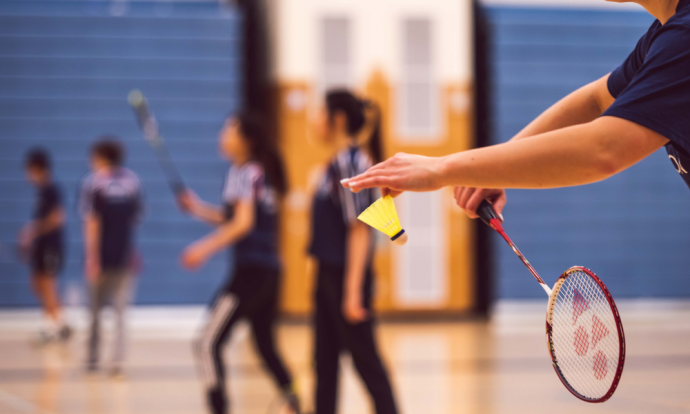The Game
The positions in a netball team are as follows:
GS – Goal Shooter – Can move anywhere within the attacking third of the court but cannot leave it.
GA – Goal Attack – Can move anywhere within the attacking third and the centre third of the court.
WA – Wing Attack – Can move within the attacking third and centre third, with the exception of the shooting circle.
C – Centre – Can move anywhere across the court, apart from either of the shooting circles.
WD – Wing Defence – Can move within the centre third and the defensive third, with the exception of the shooting circle.
GD – Goal Defence – Can move anywhere within the attacking third and the centre third of the court.
GK – Goal Keeper – Can move anywhere within the defensive third of the court but cannot leave it.
Where the teams have male players
A maximum of 3 males may take the court at one time (one in each third). If playing with 3 males on court positions are GK, C & GS. With 2 males on court they can choose to play in either GK, C or GS. If only 1 male is on court they can play in any of the 7 positions’ as they are the only male.
Positioning of players for start of play
Players are responsible at the start and restart of play:
The Centre in possession of the ball shall stand wholly within the Centre Circle, on either on or both feet
The opposing Centre shall be in the Centre Third, and free to move.
All other players shall be in the Goal Third which is part of their playing area and free to move, but none of these players are allowed in the Centre Third until the whistle has been blown to start or restart play. If one player enters the Centre Third before the whistle is blown, a free pass is awarded to the opposing team where the infringement occurred.
Start of Play
The umpire shall blow the whistle to start and restart play
The pass made by a Centre in response to the Umpire’s whistle at the start and restart of play shall be designated a Centre Pass
Play shall be started, and restarted after every goal scored, and after each interval, by a Centre pass
When the whistle is blown the Centre in possession of the ball shall throw it within three seconds and shall obey the footwork rule.
The Centre pass shall be caught or touched by any player:
Who is standing wholly within the centre third
Who lands with the first foot, or both feet, wholly within the centre third.
Playing the Ball
A player may:
Catch the ball with one or both hands
Gain or regain control of the ball if it rebounds from the goalpost o Bat or bounce the ball to another player without first having possession of it
Tip the ball in an uncontrolled manner once or more than once and then; (a) catch the ball (b) direct the ball to another player
having batted or bounced the ball once, either catch the ball or direct the ball to another player o Roll the ball to oneself to gain possession
Fall while holding the ball, but must regain footing and throw within three seconds of receiving the ball
Lean on the ball to prevent going offside o Lean on the ball on court to gain balance
Jump from a position in contact with the court and play the ball, provided that neither the player nor the ball make contact with the ground, or any object or person outside the court while the ball is being played.
A player may not:
Strike the ball with a fist.
Fall on the ball to gain possession.
Attempt to gain possession of or throw or the ball while lying, sitting or kneeling on the ground
Use the goalpost: (a) as a means of regaining balance; or (b) as a support in recovering the ball going out of court; or (c) in any other way for any other purpose, which does not include the ball rebounding from the goalpost.
Deliberately kick the ball. A free pass will be awarded to the opposing team where the infringement occurred.
Centre Pass
Over a Third
The ball may not be thrown over a complete third without being touched or caught by a player who, at the time of touching or catching the ball is standing wholly within that third, or who lands with the first foot, or both feet, wholly within that third.
A player who lands with the first foot wholly within the correct third is judged to have received the ball in that third. The subsequent throw shall be considered to have been made from the third in which the player first landed.
A player, who lands on both feet simultaneously with one foot wholly within the correct third and the other in the incorrect third, shall be penalised.
Short Pass
Footwork & Contact Rules
A player cannot let their landed/landing foot touch the floor again if they lift it away from the ground at all while in possession of the ball. Thus, it is often said that a player can only take 1.5 steps while holding the ball. They can however still balance on the other foot even if landing leg is lifted.
In an effort to attack or defend or to play the ball a player shall not:
Move into the path of an opponent who is committed to a particular landing space
Position so closely to an opponent that the player is unable to move without contacting
Push, trip, hold or lean on an opponent or use other forms of physical contact
Place a hand or hands on a ball held by an opponent
Knock or remove the ball from the possession of an opponent
Whilst holding the ball push it into an opponent
Obstruction
To defend a player with the ball you must be 3 feet away from the player’s first grounded foot.
If a player steps back or to the side, you must still be 3 feet from the player’s first grounded foot.
A player will be penalized for obstructing an opposing player that is not in possession of the ball if they are with the 3 feet distance of that player and they employ any movements which take their arms away from their body
Within this distance a player is not obstructing if their arms are outstretched to:
Catch, deflect or intercept a pass or feint pass.
Obtain a rebound from an unsuccessful shot at goal.
Momentarily signal for a pass or to indicate their intended direction of movement.
Out of Court
The ball is out of court when:
It touches the ground outside the court
It touches an object or person in contact with the ground outside the court
It is held by a player in contact with the ground, an object or a person outside the court
A ball which hits any part of the goalpost and rebounds into play, is not out of court.
A player having no contact with the ball may stand or move out of the court but, before playing the ball, the player must re-enter the court and no longer have contact with the ground out of court.
A player who has left the court to retrieve a ball or to take a throw in must be permitted direct re-entry to the court.
Power Play
Each team will elect one quarter as a Power Play when any goals scored will be doubled. The elected Power Play quarter must be notified by the team captain before the quarter commences.
Shooters may shoot from inside or outside of the Goal Circle. All successful goals from outside the Goal Circle will be worth double i.e. two Goal Points. The umpire will signal a successful Goal by raising one hand for one Goal Point and two hands for two Goal Points (In a Power Play this could result in 1 Goal scoring 2 Goal Points or 4 Goal Points)
There is no Umpire whistle after a goal is scored.
Rolling Substitutions
Unlimited number of rolling substitutions per team per quarter is allowed. Each team may make any number of rolling substitutions at any one time.
A rolling substitute may enter the game while play is in progress.
There will be a designated Substitution Box at each transverse line, where rolling substitute/s shall wait holding up a Substitution Paddle indicating the player/s to be substituted.
Team changes may not be made during a rolling substitution, as the game is not stopped Substitution Boxes for both teams are located on the same side of the court.
Professional Foul
Infringements taken at the umpire’s discretion, as a penalty pass or a shot at goal undefended.
A deliberate delay of play anytime during the duration of the game may result in the Umpire awarding the non-offending team with a five-meter forward gain in court position and/or a penalty pass or shot.
Umpires
The umpire(s) shall have sole control of the game.
The decision of the Umpire shall be final and shall be given without appeal.
The ball shall be played live if it comes into contact with an Umpire during play, but if such contact interferes with the course of the game, the Umpire may decide to have a toss ball between two opposing players in that area of play.
The Umpires whistle shall: o Start and re-start the game at the beginning of each quarter and end each period of play. o Indicate when a goal has been scored.
Indicate when an infringement of the rules has been made.
The Umpire shall:
Refrain from penalizing an infringement of the rules when by doing so the non-offending team would be placed, at a disadvantage. In this instance the Umpire may call ‘ADVANTAGE’ or use hand signals to indicate an infringement has been observed but not penalized. Having blown the whistle for an infringement, the Umpire must award the penalty.
Not criticize or coach any team while a game is in progress.
State the infringement and penalty and may use hand signals to clarify decisions.
Answer questions regarding clarification of rules from team Captains only and only at quarter breaks or at the conclusion of the game.
Advise each team of the correct score at each quarter break.
Adjudicate the rules contained in this book both consistently and without bias.
Blood Bin
Any players with bleeding wounds must leave the court. At the time the player is blood binned, the Umpire will ensure any equipment that is blood marked is replaced IMMEDIATELY and let play continue. A substitute can ONLY take up the vacant position. If no substitution is made, the injured player may return to the court only after the Umpire has been notified and a goal has been scored. Up to two minutes blood bin time can be taken.
Competition Scoring




